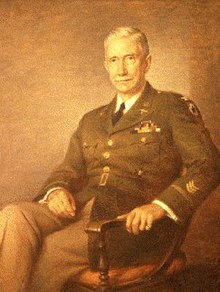Harold W. Jones
This article needs additional citations for verification. (November 2015) |
Colonel Harold W. Jones, M.D. (November 5, 1877 – April 5, 1958), is noted as the Director of the U.S. Army Medical Library from 1936 through 1945, who made signal contributions to military medicine and to the evolution of the United States National Library of Medicine (NLM).
Medical and military career
Harold Wellington Jones was born in Cambridge, Massachusetts, and after attending the Massachusetts Institute of Technology from 1894 to 1897, he enrolled in Harvard Medical School, receiving an M.D. in 1901. After two years as a resident and house physician at the Boston Children's Hospital, he entered the field of orthopedics in St. Louis, Missouri, and worked with Nathaniel Allison, who became one of his best friends. In 1904, Jones was named Associate Professor of Orthopedic Surgery at St. Louis University School of Medicine (renamed the Washington University School of Medicine in 1918). The same year saw his first medical publications, including two articles written in collaboration with Allison.
In September 1905, he decided on an army career and entered the
Jones later taught as a professor in the Army Medical School. He was subsequently (1927–1933) chief of surgery at the station hospital at Fort Sam Houston, Texas, later to become the Brooke Army Medical Center. From 1933 to 1936 he commanded the Tripler Army Medical Center in Honolulu, Hawaii.
In 1936, Colonel Jones was appointed head of the

In July 1942, he arranged for the
Jones also led an ambitious project there to edit and update the old George M. Gould Medical Dictionary, whose results were published in 1949 as "Blakiston's New Gould Medical Dictionary."
In 1943, Jones commissioned a detailed survey of the
With the exception of the new building (not approved until 1958), Jones managed to effect many of the survey's recommendations within a year. During the war years, he also formed a temporary consulting group of top physicians and librarians to advise on the operation and future development of the AML, to significant effect.
Colonel Jones had reached retirement age in November 1941, but was asked by the Surgeon General to remain on wartime duty as Director of the Army Medical Library. Finally, at the height of all these developments, he was compelled to retire at the end of 1945. In a unique twist, he ended his military career in the same building he had entered as a young lieutenant.
Some of his professional correspondence is held at the National Library of Medicine.[1]
Awards and distinctions
In 1918, Jones was decorated in France as a Chevalier of the
Character, interests, and private life
Concurrently with his other work, Colonel Jones wrote many highly regarded publications in military medicine, medical history, and medical librarianship. In addition, second only to his keen interest in medicine and surgery, he also had a great bent for travel and literary pursuits. He was an avid traveler both in Europe and in the interior of Asia and the East Indies. In 1913, he wrote a lengthy manuscript with the working title "Twenty Towns in Spain." He also wrote a number of urbane, humorous essays, first published in early volumes of the Current List of Medical Literature, which he instituted, and later issued as a vanity press volume entitled "Green Fields and Golden Apples," in 1942. Jones dedicated the collection to his late friend and colleague, Nathaniel Allison. In 1945, he wrote a short piece neatly combining many of his interests in "Some Physicians—Real and Fictional—in French Literature," which appeared in the MLA Bulletin.
In illustrating his personality, an adjutant said on meeting him in 1942 "It was easy to like Colonel Jones. He was [then] about 64 and in excellent health...handsome and erect and about six feet, six inches tall. His eyes were merry, mischievous, and bright, and his clipped white moustache made one think of a colonel from Esquire, except that he was not at all heavy for his height."
Jones and his second wife, Mary, (née Mary Winifred Morrisey, m. May 1, 1937) had an attractive home in Silver Spring, Maryland, where they liked to entertain guests, often high-ranking military friends and their wives. (Note: Jones' first marriage was to Eva Ewing Munn on January 1, 1910. She died in 1936.)
Colonel Jones died at his retirement home in Orlando, Florida, on April 5, 1958. He was buried with full military honors in Arlington National Cemetery.
See also
- U.S. Army Medical Department
- Library of the Surgeon General's Office
- United States National Library of Medicine (NLM)
- Washington University School of Medicine
- Medical Library Association (MLA)
References
- ^ "Army Medical Library Director's Correspondence 1936–1940". National Library of Medicine.
- This article uses information from US Government publications or websites and archived medical or library association journals, which are considered to be in the public domain. (See External links.)
External links
- Fulton, J. F., "The Retirement of Colonel Harold W. Jones", Bulletin of the Medical Library Association Vol. 33, pp 409–412, Oct. 1945.
- Jones, H.W. "Some Physicians—Real and Fictional—in French Literature", Bull. Med. Libr. Assoc. 33(3): 295–304, Jul. 1945.
- Keyes, T. E. (1958), "Colonel Harold Wellington Jones" (Obituary), Bull. Med. Libr. Assoc. 46: 646–649, Oct. 1958.
- Keyes, T. E. (1998), "Past Presidents I have known", Bull. Med. Libr. Assoc. 86(2): 193–201, Apr. 1998.
- Brand, R.A. (2009), "Biographical Sketch - Nathaniel Allison", Clin Orthop Relat Res (2010) 468:3–5.
- Reproduction of notes by Alan Gregg, wartime director of the Rockefeller Foundation's Medical Sciences Division, on his March 26, 1943, meeting with Jones and Metcalf about the proposed AML survey.
- Jones' March 27, 1943 letter to Metcalf, formally requesting funds for the survey and outlining its purpose and scope.
- Medical Library Association
- Cleveland Medical Library Association: history
- Mrs. Evarts E. Munn Weds Capt. Jones The New York Times, Jan. 2, 1910, page 13
- Army Medical Library Director's Correspondence (1936–1940)—National Library of Medicine finding aid

